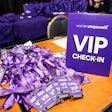There are 7.6 billion people on the planet and 3.4 billion of them are active on social media. If there's a problem at your event, it is likely to surface on social media—perhaps instantaneously.
Social media is an outlet of communication, and furthermore, it is the forum in which your clients and attendees can be heard. It is not a one-way conversation. They’re not talking at you or about you, they’re talking to you. Think of it as getting feedback forms from attendees, but it’s online for everyone to see. In today’s world, it should be part of your business strategy.
It’s important to remember that not everything discussed on social media is a true crisis. There is a scale and responses should be mitigated accordingly. A public relations crisis, for example, can involve a speaker mishap and become something that may affect your brand image or reputation, but ultimately doesn’t affect the safety of you or your attendees like a threat would. My firm, davies + dixon, has been active in events for the past several years. We've encountered a handful of crises over the years and thankfully we had a plan to follow. I want to share the key learnings with you so that you can be prepared, too.
1. Build a forgiving and trusting audience long before the conference or event.
Your annual conference or big event should not be the first time your audience is actively communicating with you and vice versa. Communities are built over time and trust has to be earned. Begin building an audience and forgiving network prior to your event. Sometimes this means a few months, but oftentimes this can mean a slow build over a few years’ time.
We experienced a scenario where there was a slip up from a vendor at a vegan festival and the attendees went to straight to social media with it. The community had been curated and cared for long before the event, and this is key to the resolution. When the event producer posted a public apology, the attendees immediately reassured her that “to err is human” and expressed how much they still loved the event.
2. Draft foundational responses.
This step is possibly the most important to maintain composure throughout an event. Try to predict any possible interactions, complaints or questions with regard to your program, venue, catering, hotel partner, speakers, Wi-Fi, baggage storage, mobile app, etc. Draft sample responses to all outcomes (within the Twitter character count or less) and include helpful, pre-shortened links to direct people (including one to your feedback form or attendee survey!). Always tailor responses accordingly so that users feel they are still speaking to a human.
In addition to the common discussions, prepare for the worst. What are the local fire and police department Twitter handles? Local news sources? In case an emergency surfaces.
For example, during one of our clients’ 20,000-person conference, an active shooter was identified about 10 blocks away from the convention center. We had approximately 15 minutes before the knowledge spread throughout the conference on social media. We were able to calmly keep attendees (all of whom were safe) informed by retweeting the local police department’s live updates. Getting information straight from the source helps keep attendees at ease.
If you receive a complaint about the temperature of the room (who hasn’t?), here are variations of responses to draft:
> If they alert you of the problem, but don’t specify location:
Thanks for alerting us. Where are you located? We will immediately alert staff to assess. EVENT HASHTAG
> If they specify the problem and location:
Thanks for alerting us. Staff is on its way to appropriately adjust temperature. EVENT HASHTAG
> If your team is already addressing the problem:
Thanks for reaching out. Our staff is aware and adjusting appropriately. EVENT HASHTAG
> If they complain generally about temperature, but there will be no change (due to general attendee comfortability):
Thanks for the feedback. We are monitoring room temperature to keep climate in a condition most suitable for the general audience. EVENT HASHTAG
3. Decide what makes a post “viral.”
This looks different for every brand, organization, event or conference. Decide the distinction ahead of time and then draft appropriate response plans accordingly. For example, if only one person is negatively posting on social media, it can likely be contained and addressed between the organization (you) and the individual. But perhaps if similar sentiments about the same topic are being discussed by 10 or more people—and this hits your pre-identified “now-it’s-viral” level—you may strategically choose to address the discussion with a public post from the organization or during the next keynote introduction, for example.
4. Monitor your hashtag consistently.
The sooner an issue or crisis can be identified and responded to, the quicker the solution can be activated. Sometimes, people just want to be acknowledged, and other times, actual solutions are required. Either way, you don’t want negativity to spread, so reacting sooner rather than later can be the preventative solution. Remember to monitor variations of your hashtag too (i.e. incorrect or alternative versions).
Do not delete negative posts unless absolutely necessary. Respond with a cool, calm and collected statement like, “We appreciate your perspective. We’d like to invite you to call our Director of XYZ to discuss further, please DM for details.” The point is to respond and respond timely and publicly to show that you’ve taken care of the issue. Especially in today’s world, transparency, authenticity and genuine care are valued and appreciated by consumers.















